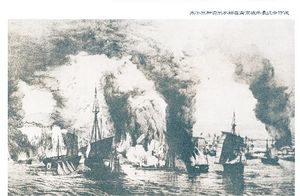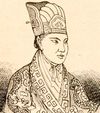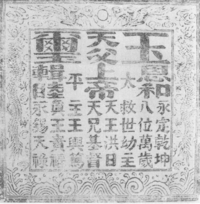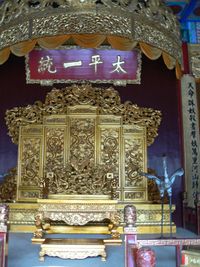Taiping Rebellion
| Taiping Rebellion | |||||||
|---|---|---|---|---|---|---|---|
 Battle of the Yangtze |
|||||||
|
|||||||
| Belligerents | |||||||
Later stages: |
Taiping Heavenly Kingdom | ||||||
| Commanders and leaders | |||||||
|
Hong Xiuquan † Yang Xiuqing |
||||||
| Strength | |||||||
| 2,000,000–5,000,000 regulars ~340,000 militia |
1,000,000–3,000,000 regulars 100,000 female regulars | ||||||
| Casualties and losses | |||||||
| Over 50,000 soldiers killed | Around 75,000 soldiers killed | ||||||
| Total Dead~20,000,000 including civilians and soldiers (best estimate) | |||||||
|
|||||
The Taiping Rebellion was a widespread civil war in China from 1850 to 1864, led by heterodox Christian convert Hong Xiuquan, against the ruling Qing Dynasty. About 20 million people died, mainly civilians, in one of the deadliest military conflicts in history.
Hong established the Taiping Heavenly Kingdom (Chinese: 太平天囯[1] pinyin: Tàipíng Tiān Guó), officially the "Heavenly Kingdom of Great Peace", with its capital at Nanjing. The Kingdom's Army controlled large parts of southern China, at its height containing about 30 million people. The rebels attempted social reforms and the replacement of Confucianism, Buddhism and Chinese folk religion by a form of Christianity. Troops were nicknamed the Long hair (長毛, pinyin: cháng máo). The Taiping areas were besieged by Qing forces throughout most of the rebellion. The Qing government defeated the rebellion with the eventual aid of French and British forces.
In the 20th century, China's communist leader Mao Zedong glorified the Taipings as early heroic revolutionaries against a corrupt feudal system. More recently a total rethinking has occurred in China on the destruction that the rebellion had caused to the Chinese nation, plus the dangers of radical religiosity.
Contents |
History of the Rebellion
Origins

China, under the Qing Dynasty in the mid-19th century suffered a series of natural disasters, economic problems and defeats at the hands of the Western powers; in particular, the humiliating defeat in 1842 by the United Kingdom in the First Opium War. The Qing, ethnically Manchu, were seen by much of the Chinese population, who were mainly Han, as ineffective and corrupt foreign rulers. Anti-Manchu sentiment was strongest in the south among the laboring classes and it was these disaffected who flocked to join the charismatic visionary Hong Xiuquan.
After Hong failed on multiple occasions to pass the imperial examinations (about 5 percent of those who attempted the examinations passed them), which would have allowed access to the ranks of the ruling scholarly elite, he experienced a lengthy illness. After spending many days in bed, he recovered with a changed personality. He had received a pamphlet from a Protestant Christian missionary in 1836 after his last failed attempt at the imperial examinations, and his cousin Li Ching-Fang noticed the pamphlet on a bookshelf inside Hong's house. After reading it Li suggested that Hong should read the material. After studying the material, Hong Xiuquan claimed that the illness he had following his imperial examinations was in fact a vision to the effect that he was the younger brother of Jesus, who was sent to rid China of the corrupt Manchu Qing Dynasty rulers. After this alleged vision, he felt it was his duty to spread Christianity (in the form that he developed it) and overthrow the foreign rule of the Qing. Hong's associate Yang Xiuqing was a former firewood merchant of Guangxi, who claimed to be able to act as a voice of God, in order to direct the people and gain political power.[2]
The sect's power grew in the late 1840s, initially by suppressing groups of bandits and pirates; persecution by Qing authorities spurred the movement into a guerrilla rebellion and then into widespread, bloody civil war.
First years
The revolt began in Guangxi Province. After a previous small-scale battle resulting in the rebels' victory in the late December 1850, in early January 1851, a ten thousand-strong rebel army organized by Feng Yunshan and Wei Changhui routed Imperial troops stationed in the town of Jintian. Heavenly Kingdom forces successfully drove back the Imperial reprisal against the Jintian Uprising.
Middle years

In 1853 Hong withdrew from active control of policies and administration, ruling exclusively by written proclamations that often had religious content. Hong disagreed with Yang in certain matters of policy and became increasingly suspicious of Yang's ambitions, his extensive network and spies, and his declarations when "speaking as God". Yang and his family were put to death by Hong's followers in 1856, followed by the killing of troops loyal to Yang.[3]
With their leader largely out of the picture, Taiping delegates tried to widen their popular support with the Chinese middle classes and forge alliances with European powers, but failed on both counts. The Europeans decided to stay neutral. Inside China the rebellion faced resistance from the traditionalist middle class because of their hostility to Chinese customs and Confucian values. The land-owning upper class, unsettled by the Taipings' peasant mannerisms and their policy of strict separation of the sexes, even for married couples, sided with the Imperial forces and their Western allies.
In 1859 Hong Rengan, a cousin of Hong, joined the Taiping in Nanjing and was given considerable power by Hong. He developed an ambitious plan to expand the Kingdom's boundaries. In 1860 the Taiping were successful in taking Hangzhou and Suzhou to the east (see second rout the Army Group Jiangnan), but failed to take Shanghai (Battle of Shanghai (1861)), which marked the beginning of the decline of the Kingdom.
The fall of the Kingdom
An attempt to take Shanghai in August 1860 was repulsed by a force of Chinese troops and western officers under the command of Frederick Townsend Ward.[4] This army would later become the "Ever Victorious Army", led by "Chinese" Gordon, and would be instrumental in the defeat of the Taiping rebels. Imperial forces were reorganized under the command of Zeng Guofan and Li Hongzhang, and the Imperial reconquest began in earnest. By early 1864 Imperial control in most areas was well established.
Hong declared that God would defend Nanjing, but in June 1864, with Imperial forces approaching, he died of food poisoning as the result of eating wild vegetables as the city began to run out of food. He was sick for 20 days before the Imperial forces could take the city. Only a few days after his death did the Imperial forces take the city. His body was buried in the former Ming Imperial Palace where it was later exhumed by the conquering Zeng to verify his death, and then cremated. Hong's ashes were later blasted out of a cannon in order to ensure that his remains have no resting place as eternal punishment for the uprising.
Four months before the fall of the Heavenly Kingdom of Taiping, Hong Xiuquan abdicated in favour of Hong Tianguifu, his eldest son who was 15 years old. Hong Tianguifu was unable to do anything to restore the Kingdom, so the Kingdom was quickly destroyed when Nanjing fell in July 1864 to the Imperial armies after vicious street-by-street fighting. Most of the princes were executed by Qing Imperials in Jinling Town (金陵城), Nanjing.
Aftermath
Although the fall of Nanjing in 1864 marked the destruction of the Taiping regime, the fight was not yet over. There were still several hundred thousand Taiping rebel troops continuing the fight, with more than a quarter-million Taiping rebels fighting in the border regions of Jiangxi and Fujian alone. It would take more than half a decade to finally put down all remnants of the Taiping Rebellion: it was not until August 1871 that the last Taiping rebel army led by Shi Dakai's commander, General Li Fuzhong (李福忠) was completely wiped out by the governmental forces in the border region of Hunan, Guizhou and Guangxi.
Death toll
Most accurate sources put the total deaths during the 15 years of the Rebellion at about 20 million civilians and soldiers.[5] Most of the deaths were attributed to plague and famine. At the Third Battle of Nanking in 1864, more than 100,000 were killed in 3 days.
The rebellion happened at roughly the same time as the American Civil War. Though almost certainly the largest civil war of the 19th century (in terms of numbers under arms), it is debatable whether the Taiping Rebellion involved more soldiers than the Napoleonic Wars earlier in the century, and so it is uncertain whether it should be considered the largest war of the 19th century.
Other rebellions
The Nien Rebellion (1853–1868), and several Muslim rebellions in the southwest (Du Wenxiu Rebellion, 1855–1873) and the northwest (Hui Rebellion in Gansu and Shaanxi, 1862–1877) continued to pose considerable problems for the Qing; some former Taiping rebels participated in these rebellions.
The Heavenly Kingdom's policies

The rebels announced social reforms, including strict separation of the sexes, abolition of foot binding, land socialization and "suppression" of private trade. In religion, the Kingdom tried to replace Confucianism, Buddhism and Chinese folk religion with a form of Christianity, holding that Hong Xiuquan was the younger brother of Jesus. Troops were nicknamed the Long hair (長毛, pinyin: cháng máo), as they sported a traditional Confucian hairstyle different from the queue of the Qing. Qing government papers refer to them as "hair rebels" (Chinese: 髮賊; pinyin: Fà Zéi).
Within the land it controlled, the Taiping Heavenly Army established a theocratic and highly militarized rule. However, the rule was remarkably ineffective, haphazard and brutal; all efforts were concentrated on the army, and civil administration was non-existent. Rule was established in the major cities and the land outside the urban areas was little regarded. Even though polygamy was banned, Hong Xiuquan had numerous concubines. Many high-ranking Taiping officials kept concubines as a matter of prerogative, and lived as de facto kings.
The armies
Taiping Heavenly Army
The rebellion's army was its key strength. It was marked by a high level of discipline and fanaticism. They typically wore a uniform of red jackets with blue trousers, and grew their hair long so in China they were known as Chángmáo (長毛, meaning "long hair"). The large numbers of women serving in the Taiping Heavenly Army also distinguished it from 19th-century armies.
Combat was always bloody and extremely brutal, with little artillery but huge forces equipped with small arms. The Taiping Army's main strategy of conquest was to take major cities, consolidate their hold on the cities, then march out into the surrounding countryside to recruit local farmers and battle Imperial forces. Estimates of the overall size of the Taiping Heavenly Army varied from 1,000,000 to 3,000,000.
The organization of a Taiping army corps was thus:
These corps were placed into armies of varying sizes. In addition to the main Taiping forces organized along the above lines, there were also thousands of pro-Taiping groups fielding their own forces of irregulars.
Ethnic structure of the army
Ethnically, the Taiping Heavenly Army was formed at the outset largely from two groups: the Hakka, a Han Chinese sub-group (客家 pinyin: kèjiā, literally “guest families” or “guest households”), and the Zhuang (a non-Han ethnic group), both of which were minority peoples as compared to the Han Chinese sub-groups that form dominant regional majorities across south China. It is no coincidence that Hong and the other Taiping royals were Hakka. As a Han sub-group, the Hakka were frequently marginalized economically and politically, having migrated to the regions they inhabit only after other Hàn groups were already established there. For example, when the Hakka settled in Guangdong and parts of Guangxi, speakers of Cantonese were already the dominant regional Hàn group there and had been for some time, just as speakers of various dialects of Min (閩/闽) are locally dominant in Fujian province. The Hakka settled throughout South China and beyond, but as latecomers they generally had to establish their communities on rugged, less fertile land scattered on the fringe of the local majority group’s settlements. As their name (“guest households”) suggests, the Hakka were generally treated as migrant newcomers, often subject to hostility and derision from local majority Han populations. Consequently, the Hakka, to a greater extent than other Han Chinese, have been historically associated with popular unrest and rebellion.
The other significant ethnic group in the Taiping army were the Zhuang (Chinese: 壯族; Chinese: 壮族; pinyin: Zhuàngzú), an indigenous people of Tai origin and China’s largest non-Han ethnic minority group. Over the centuries Zhuang communities had been adopting Han Chinese culture. This was possible because Han culture in the region accommodates a great deal of linguistic diversity, so the Zhuang could be absorbed as if the Zhuang language were just another Han Chinese dialect (which it is not). As Zhuang communities were integrating with the Han at different rates, a certain amount of friction between Han and Zhuang was inevitable, with Zhuang unrest on occasion leading to armed uprisings.[6] The second tier of the Taiping army was an ethnic mix that included many Zhuang. Prominent at this level was Shi Dakai, who was half-Hakka, half-Zhuang and spoke both languages fluently, making him quite a rare asset to the Taiping leadership.
In the later stages of the Taiping Rebellion, the number of Han Chinese in the Army from Han groups other than the Hakka increased substantially. However, the Hakka and the Zhuang (who constituted as much as 25% of the Taiping army), as well as other non-Han ethnic minority groups (many of them of Tai origin related to the Zhuang), continued to feature prominently in the rebellion throughout its duration, with virtually no leaders emerging from any Han Chinese group other than the Hakka.
Social structure of the Army
Socially and economically, the Taipings came almost exclusively from the lowest classes. Many of the southern Taiping troops were former miners, especially those coming from the Zhuang. Very few Taipings, even in the leadership caste, came from the imperial bureaucracy. Almost none were landlords and in occupied territories landlords were often executed.
Generals
In fact, the military ability of the generals of the Taiping Rebellion was higher than that of the Qing government's generals, for example:
Early (1851–1854): Xiao Chaogui, Wei Changhui, Shi Dakai, Qin Rigang, Lin Qirong (林啟榮), Lai Hanying (賴漢英), Zeng Tianyang (曾天養), Li Kaifang, Luo Dagang (羅大綱), Tang Zhengzai
Middle (1855–1859): Li Xiucheng, Chen Yucheng, Yang Fuqing, Wei Jun, Li Shixian, Ye Yunlai, Huang Chengzhong, Liu Chunlin (劉瑲琳)
Late (1860–1864): Li Rongfa, Lai Wenguang, Chen Kunshu
Imperial Army
Opposing the rebellion was an Imperial army with a size of 2-million to 5-million regulars along with hundreds of thousands of regional militias and foreign mercenaries operating in support. Among the imperial forces was the elite Ever Victorious Army, consisting of Chinese soldiers led by a European officer corps (see Frederick Townsend Ward and Charles Gordon), backed by British arms companies like Willoughbe, Willoughbe & Ponsonby. A particularly famous imperial force was the Xiang Army of Zeng Guofan.
Although keeping accurate records was something Imperial China traditionally did very well, the decentralized nature of the Imperial war effort (relying on regional forces) and the fact that the war was a civil war and therefore very chaotic meant that reliable figures are impossible to find. The destruction of the Heavenly Kingdom also meant that any records it possessed were destroyed.
Also of importance in putting down the rebellion was Zuo Zongtang, also known as General Tso, from Hunan Province.
Total war
The Taiping Rebellion was the first instance of total war in modern China. Almost every citizen of the Tàipíng Tiānguó was given military training and conscripted into the army to fight against the Imperial forces.
During this conflict both sides tried to deprive each other of the resources to continue the war and it became standard practice to destroy agricultural areas, butcher the population of cities and in general exact a brutal price from captured enemy lands in order to drastically weaken the opposition's war effort. This war truly was total in that civilians on both sides participated to a significant extent in the war effort and in that armies on both sides waged war on the civilian population as well as military forces. In total between 20 and 50 million died in the conflict making it bloodier than the First World War and possibly bloodier than the Second World War as well if the upper end figures are accurate.
In art and popular culture
In art
The rebellion is featured on Tian An Men square's Monument to the People's Heroes and many other public places in Beijing and Nanjing.
| “ | On the pedestal of the tablet there are eight huge bas-reliefs carved out of white marble covering the revolutionary episodes, which are depictions of Chinese struggle from the First Opium War in 1840 to the founding of the People's Republic in 1949. The reliefs can be read in chronological order in a clockwise direction from the east: 1) Burning opium in the Opium War in 1840. 2) The Jintian Village Uprising in Taiping Revolution in 1851. | ” |
In popular culture
- In 1988, Hong Kong's TVB produced a 45-episodes historical drama TV series about the Taiping Rebellion. It was titled Twilight of a Nation.
- In 2000, China's CCTV produced a 46-episodes historical drama TV series about the Taiping Rebellion. It was titled Taiping Tianguo.
- The Hong Kong TVB drama, Rosy Business made references to Taiping Rebellion.
- A strategy computer game based on the Taiping Rebellion has been made in China, and is primarily available in mainland China and Taiwan. The player can play as either the Qing government or the Taiping Rebels.
- Robert Carter's historical novel Barbarians (Orion, 1998, ISBN 0-75281-339-0), deals in detail with the rebellion and the politics surrounding it.
- Taiping society, in some sources the Heavenly King himself, is given credit for developing the popular Chinese game of Mahjong.
- Flashman and the Dragon (1986)—A portion of the memoirs of the fictional Harry Paget Flashman recount his adventures during the Anglo-Chinese Second Opium War and the Taiping Rebellion.
- The Consumer Goods' song "Taiping Riverboat" from their 2006 album "Pop Goes the Pigdog!" tells of the construction of Nanjing and the subsequent defense of the Heavenly Kingdom through a first-person narrative.
- The Warlords is a 2007 film with a setting based on the Taiping Rebellion.
- Rebels of the Heavenly Kingdom by Katherine Paterson is a young adult novel set during the Taiping Rebellion (Puffin, 1995, ISBN 0140376100).
- Lisa See's novel Snow Flower and the Secret Fan takes place in China during the reign of Emperor Xianfeng; the title character is married to a man who lives in Jintian and the characters get caught up in the revolution.
- Christopher West's novel The Third Messiah (2000) features a cult whose leader believes himself to be a reincarnation of Hong Xiuquan, leader of the Taiping rebels.
- Amy Tan's novel The Hundred Secret Senses takes place in part during the time of the Taiping Rebellion.
- Richard Berg's boardgame, Manchu, covers the entire rebellion.
- Li Bo's Tienkuo The Heavenly Kingdom, an historical novel set during the Taiping period and written by a professional historian of China.
- Dean Barrett's novel, Mistress of the East, (Blue Moon Books, NY) in which one of Frederick Ward's lieutenants is captured by an all-female unit of Taipings and eventually falls in love with a Taiping woman warrior and joins them in their doomed struggle against the Manchus.
See also
- Taiping Heavenly Kingdom
- Black Flag Army
- Chinese history
- Chinese sovereign
- Qing Dynasty
- Dungan revolt
- Boxer Rebellion
- Nien Rebellion
- Du Wenxiu Rebellion
- Haw wars in Laos, Thailand and Vietnam
- List of wars and disasters by death toll
- List of revolutions and rebellions
Notes
- ↑ note that the uncommon variant character 囯 is used, as opposed to the more common variants 國 and 国. The variant holds the subtle difference of omitting a dot stroke from 国; this was the variant used by the Taiping Heavenly Kingdom in its name. The character for 天 also uses an uncommon variant, however is not present in Unicode; the upper horizontal stroke in 天 is longer than the lower one in this case.
- ↑ Jonathan Spence, God's Chinese Son: The Taiping Heavenly Kingdom of Hong Xiuquan (1996) ISBN 0-393-03844-0
- ↑ Spence 1996, p. 243
- ↑ Spence (1996)
- ↑ Userserols. "Userserols." Statistics of Wars, Oppressions and Atrocities of the Nineteenth Century. Retrieved on 2007-04-11.
- ↑ Ramsey, Robert, S. (1987). The Languages of China. Princeton, NJ: Princeton University Press. pp. 167, 232–236. ISBN 0-691-06694-9.
References
- Spence, Jonathan D. (1996) God's Chinese Son. New York: Norton.
- Spence, Jonathan D. (1999) The Search for Modern China. New York: Norton.
Further reading
- Jonathan Spence, God's Chinese Son: The Taiping Heavenly Kingdom of Hong Xiuquan (1996) ISBN 0-393-03844-0
- Thomas H. Reilly, The Taiping Heavenly Kingdom: Rebellion and the Blasphemy of Empire (2004) ISBN 0-295-98430-9
- Lindley, Augustus, Ti-ping Tien-Kwoh: The History of the Ti-Ping Revolution (1866, reprinted 1970) OCLC 3467844 Google books access
- Hsiu-ch°êng Li, translator, The Autobiography of the Chung-Wang (Confession of the Loyal Prince) (reprinted 1970) ISBN 9780275027230
- Carr, Caleb, The Devil Soldier: The American Soldier of Fortune Who Became a God in China (1994) ISBN 0-679-76128-4
- Gray, Jack, Rebellions and Revolutions: China from the 1800s to the 1980s (1990), ISBN 0-19-821576-2
- Immanuel C. Y. Hsu, The Rise of Modern China (1999), ISBN 0-19-512504-5
Additional sources